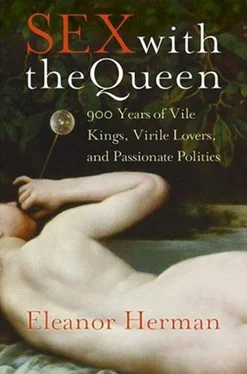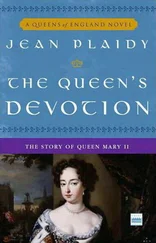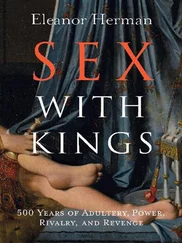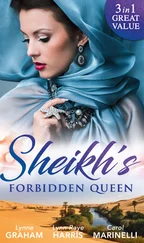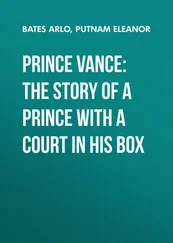The duchess further obtained an award for Conroy from Portugal, which included the signal honor that wherever he walked, guards preceding him would drum in his honor. But Conroy never made it to Portugal, even though he tried to organize several trips over the years—just to hear the drums.
3. MEDIEVAL QUEENS, TUDOR VICTIMS
Uneasy lies the head that wears a crown.
—WILLIAM SHAKESPEARE
HUMAN NATURE BEING WHAT IT IS, WE CAN ASSUME THAT back in the cave the mate of the powerful chief—the man who wielded a big stick to bring home mammoth meat—looked with lust upon a muscular young hunter and wondered about the size of his stick. Alas, records of Ice Age love affairs simply don’t exist.
Nor are there many records that attest to medieval queens taking lovers. Expected to reflect the virtues of the Virgin Mary, most queens probably never considered adultery as an option, no matter how horrible their husbands were. And yet, having examined the emptiness of palace life and the sorrows of the marital bed, well can we understand why a queen would have been unfaithful. Looking at the earliest stories of adulterous queens, we are unsure whether to condemn their weakness or applaud their courage.
In 1109 King Alfonso VI of Castile and Leon forced his widowed daughter and heir, Princess Urraca, to marry Alfonso the Battler, king of Aragon. Feeling his end drawing near, Alfonso VI wanted his daughter to have the protection of a fierce warrior
husband at her side. He died soon after the wedding and never saw Alfonso of Aragon and Urraca of Castile and Leon battling each other for decades. Though valiant on the battlefield, Alfonso was probably useless in bed; no one at court could comprehend his aversion to whores, mistresses, and women in general. Urraca detested her husband and soon abandoned him.
But Urraca had little need of Alfonso on the battlefield. She hopped on a horse herself and spent thirteen campaign seasons out of her seventeen years’ rule waging war against unruly neighbors. Her top military commander was her lover Pedro Gonzalez, a powerful noble, whom she bore at least two illegitimate children. The queen died at the age of forty-six, giving birth to twins, some said, though no one knows. Records of the life of this intriguing woman are few and far between.
ELEANOR OF AQUITAINE, QUEEN OF FRANCE
“I Find I Have Wed a Monk”
When eighteen-year-old Louis VII of France married the spirited fifteen-year-old Eleanor of Aquitaine in 1137, he would have gladly bedded her often, but his priests prevented it. Young as she was, she sized up her husband’s band of bleating clerics at a glance and dismissed them as worthless. They sized her up, too, and were alarmed; they had wielded unlimited power over the impressionable young king. Now this power was threatened by a headstrong girl whom Louis deeply loved. The renowned abbot Bernard of Clairvaux wrote the king that he was under the “counsel of the devil,” the devil being Queen Eleanor. 1
Louis’s priests often pulled the king out of his marital bed, leaving Eleanor seething with anger amongst the pillows. As a result of the priests’ interventions, in a decade of marriage, Eleanor gave her husband only one child—a useless girl. “I thought to have married a king,” she snarled, “but find I have wed a monk.” 2
When a penitent Louis VII vowed to go on crusade in 1146 to atone for his sins, Eleanor, bored to tears in her dark cold palace in muddy Paris, insisted on accompanying him. Various reports credited her with dressing as an Amazon in a silver breastplate as the cavalcade crossed the Hungarian plains. Once in the Holy Land, Eleanor probably had a rollicking affair with her uncle, the virile warrior Raymond of Poitiers who had claimed the kingdom of Antioch as his own. Thirty years after her visit to Antioch, the chronicler William of Tyre wrote, “Her conduct before and after this time showed her to be far from circumspect. Contrary to her royal dignity, she disregarded her marriage vows and was unfaithful to her husband.” 3
When King Louis was ready to move on to Jerusalem, Eleanor told her husband that he might do as he pleased but she would stay behind with Uncle Raymond. Stunned, Louis asked her the reason behind her eagerness to abandon him. Eleanor supposedly retorted, “Why do I renounce you? Because of your fecklessness. You are not worth a rotten pear.” 4
Weak and ineffectual, Louis didn’t know what to do. But his advisers convinced the king, “It would be a lasting shame to the kingdom of the Franks if, in addition to all the other disasters, it was reported that the King had been deserted by his wife, or robbed of her.” 5Despite her probable adultery, Eleanor would be kept as queen as a matter of prestige, as well as for the rich lands she brought to France, lands which would depart with her in the event of a divorce.
When a signal was given for the French army to move out, the queen was scooped up in the middle of the night, slung over a horse, and forced to continue on crusade as a dutiful wife. She never saw her swaggering uncle again. Soon after her inglorious departure, he fell in battle against the Saracens, who plated his skull with silver and made it into a drinking cup.
In 1152 Louis gave in to Eleanor’s pleas for a divorce on the grounds of consanguinity; they were fourth cousins, too closely related to a common ancestor to be legally married in the eyes of the church without a special dispensation. The real reason for a divorce, of course, was never consanguinity, which was a convenient excuse to end an unbearable marriage in a church that officially did not permit divorce. In Eleanor’s case the real reason was that she had not given her husband a son.
Two months after her divorce she married the future Henry II of England, upon whom she bestowed her rich dower lands of Aquitaine as well as five sons and three daughters. Though more is known about Eleanor of Aquitaine than Urraca of Castile and Leon, much of her story was first written down decades after it occurred, often by scribes with political motivations for making her look good or evil and is, as such, suspect.
ISABELLA OF FRANCE, QUEEN OF ENGLAND
“Someone Has Come Between My Husband and Myself”
Far better records exist for Isabella of France, who in 1308 at the age of twelve married the handsome twenty-four-year-old Edward II of England. At the time of the wedding Edward had already been in love with another man, Piers Gaveston, for a decade. According to a contemporary chronicler, “As soon as the King’s son saw him, he fell so much in love that he entered upon an enduring compact with him.” 6
After the nuptial celebrations in France, Edward sent all of the wedding gifts he had received from his father-in-law King Philip—gold rings and other jewels—back home to Gaveston as a present, which infuriated the French court. When the bride and groom landed in England, Edward leapt off the gangplank and ran into the arms of the waiting Gaveston. The new queen was left to clamber down the plank as best she could. At the coronation, it was Gaveston and not Isabella who seemed to be guest of honor. Edward had tapestries made for the coronation bearing not the arms of Edward and Isabella, as tradition demanded, but the arms of Edward and Gaveston, as if Edward had made Gaveston his queen.
The child-queen, unsure of herself at a foreign court, put up with the relationship but must have been relieved when four years later jealous barons, many of whom had lost their lands and castles to Gaveston, murdered him. The king became devoted to his wife and allowed her to rule England for him. But in 1320, after eight years of marital peace, Edward chose another favorite, actually two favorites, father and son, Hugh Le Despenser the Elder and Hugh Le Despenser the Younger. Though the facts are murky, it is assumed that the king was having an affair only with the son, and the father was a close political adviser exploiting the relationship to reap advantages for the family. In 1321, as the Le Despensers’ star rose, Isabella’s faded. The new favorites convinced the king to decrease her authority, honors, and income.
Читать дальше
